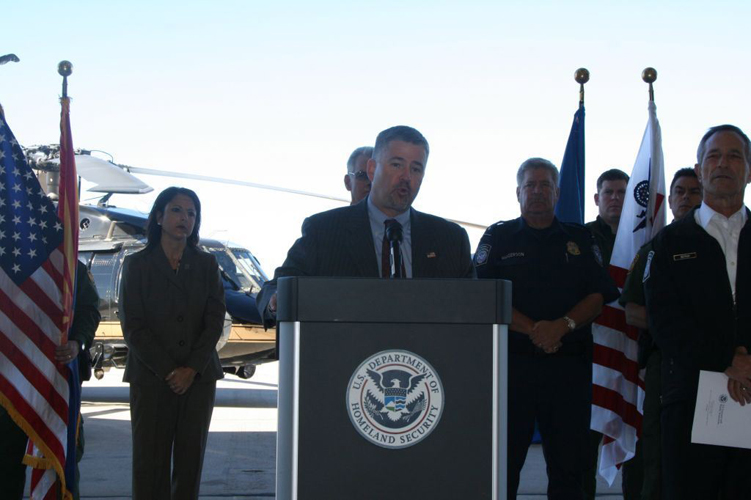Archived Content
In an effort to keep ICE.gov current, the archive contains content from a previous administration or is otherwise outdated. This information is archived and not reflective of current practice.
ICE part of unprecedented, multi-agency effort securing border in Arizona
Tucson, Ariz. - U.S. Immigration and Customs Enforcement's (ICE) Homeland Security Investigations (HSI) Special Agent in Charge for Arizona Matthew Allen, along with U.S. Customs and Border Protection (CBP) Commissioner Alan Bersin and Tucson Sector Border Patrol Chief Randy Hill, announced the results to date of the Alliance to Combat Transnational Threats (ACTT).
ACTT is a collaborative enforcement effort launched in September 2009 that leverages the capabilities and resources of more than 60 federal, state, local and tribal agencies in Arizona and the Government of Mexico. Together, these entities combat individuals and criminal organizations that pose a threat to communities on both sides of the border.
Since its inception, ACTT has resulted in:
- The seizure of more than 1.6 million lbs. of marijuana, 3,800 lbs. of cocaine, and 1,000 lbs. of methamphetamine;
- The seizure of more than $13 million in undeclared U.S. currency and 268 weapons;
- Nearly 14,000 aliens denied entry to the U.S. at Arizona ports of entry due to criminal background or other disqualifying factors; and
- About 270,000 apprehensions between ports of entry.
Further, Allen said "ICE is firmly committed to ensuring our borders are secure, and the agency is reinforcing its efforts to disrupt and reduce the illicit flow of guns, money, drugs, and criminals in both directions across the border."
ICE's commitment to the ACTT extends to the entire agency. Both HSI and ICE's Enforcement and Removal Operations (ERO) are integral partners with members on the Unified Command and resources permanently assigned to ACTT executive staff.
ICE works with partner agencies to cohesively target smuggling routes and corridors into Phoenix, and ICE agents are leveraging the resource and intelligence capabilities of ACTT to secure the safety of Arizona communities.
Supported by ACTT, ICE has accomplished the following:
- April 2010 - Operation In Plain Sight resulted in ICE denying human smuggling organizations the use of commercial transportation in the movement of illegal aliens from Tucson into Phoenix.
- August 2010 - HSI agents, working with the CBP Office of Field Operations in Lukeville, Ariz., opened a criminal investigation into a weapons trafficking organization that resulted in the disruption of a smuggling scheme.
ICE's priority on effective immigration enforcement that targets criminal aliens has also been incorporated into ACTT.
- ICE ERO created the Joint Criminal Alien Removal Task Force (JCART), which focuses on identifying and arresting criminal aliens unlawfully living in Arizona.
- ICE ERO has also contributed additional resources to the Violent Criminal Alien Section, which seeks to support the felony prosecution of aggravated felons who unlawfully reenter Arizona following deportation.
Since launching the Southwest Border Initiative (SBI) in March 2009, the Obama administration has engaged in an unprecedented effort to bring focus and intensity to Southwest border security, coupled with a reinvigorated, smart and effective approach to enforcing immigration laws in the interior of our country.
DHS has doubled the number of ICE personnel assigned to Border Enforcement Security Task Forces (BEST); increased the number of intelligence analysts working along the U.S.-Mexico border; quintupled deployments of Border Liaison Officers; deployed thousands of technology assets - including mobile surveillance units, thermal imaging systems, and large-and small-scale non-intrusive inspection equipment - at and between the ports of entry; and begun screening of southbound rail and vehicle traffic for the illegal weapons and cash that are helping to fuel the cartel violence in Mexico. Also, the Border Patrol is better staffed than at any time in its history, having doubled the number of agents from about 10,000 in 2004 to more than 20,700 in 2010.
These investments have also produced significant results. Border Patrol apprehensions-a key indicator of illegal immigration-have decreased 36 percent in the past two years and are less than half of what they were at their peak; violent crime in border communities has remained flat or fallen in the past decade. Statistics show that some of the safest communities in America are on the border.
In addition, in fiscal years 2009 and 2010, ICE and CBP seized more than $282 million in illegal currency, more than 7 million pounds of drugs, and more than 6,800 weapons along the entire Southwest border - increases of more than $73 million, more than 1 million pounds of drugs and more than 1,500 weapons compared to 2007 and 2008. In the coming months, DHS will continue to deploy additional resources to the Southwest border.


